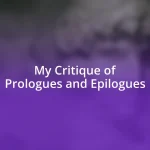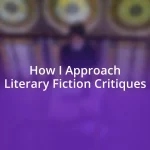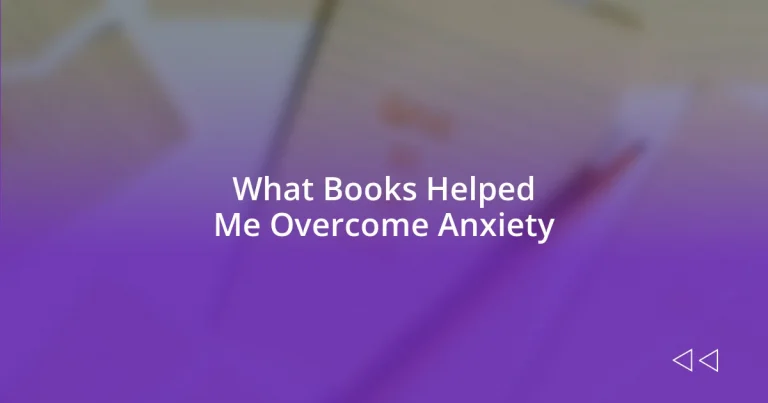Key takeaways:
- Understanding anxiety involves recognizing triggers and patterns, which is the first step toward healing.
- Selecting the right self-help books can provide comfort and practical tools, with themes of self-compassion and mindfulness being particularly supportive.
- Applying lessons from reading through actionable steps and sharing insights with others enhances understanding and fosters a supportive community during the healing journey.
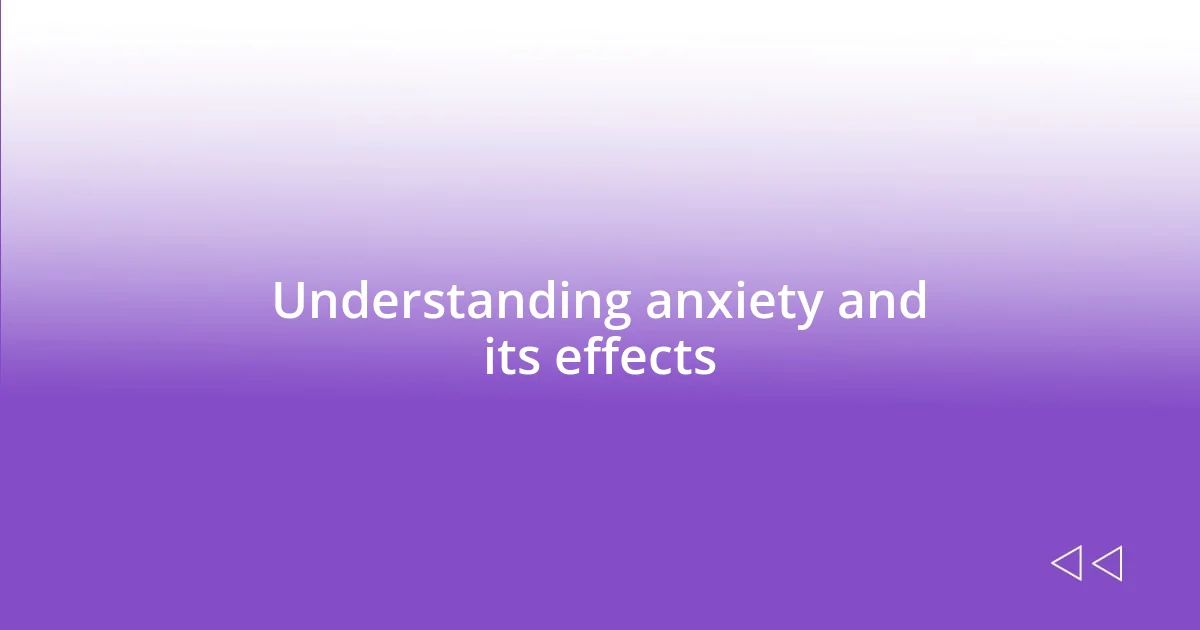
Understanding anxiety and its effects
Anxiety can feel like a relentless storm within, often leaving you feeling overwhelmed and isolated. I once found myself in a cycle of worrying about everything from my daily tasks to future uncertainties, and it made me question my ability to cope. Have you ever felt like you were on a roller coaster of emotions, with your heart racing and thoughts spiraling out of control? It’s a tough place to be.
What’s fascinating yet troubling about anxiety is how it manifests physically. For me, it wasn’t just my mind racing; my body responded too, with tightness in my chest and difficulty breathing. It’s remarkable how our mental state can impact our physical well-being, making even the simplest tasks feel monumental. Have you ever noticed how anxiety can creep in and disrupt your focus on activities you once enjoyed?
Understanding anxiety is key to managing it. I’ve learned that recognizing my triggers and patterns has been incredibly beneficial. It’s as if I’m peeling back layers to understand better what’s happening inside me. Could it be that just acknowledging our feelings and experiences can be the first step towards healing? I truly believe it can.
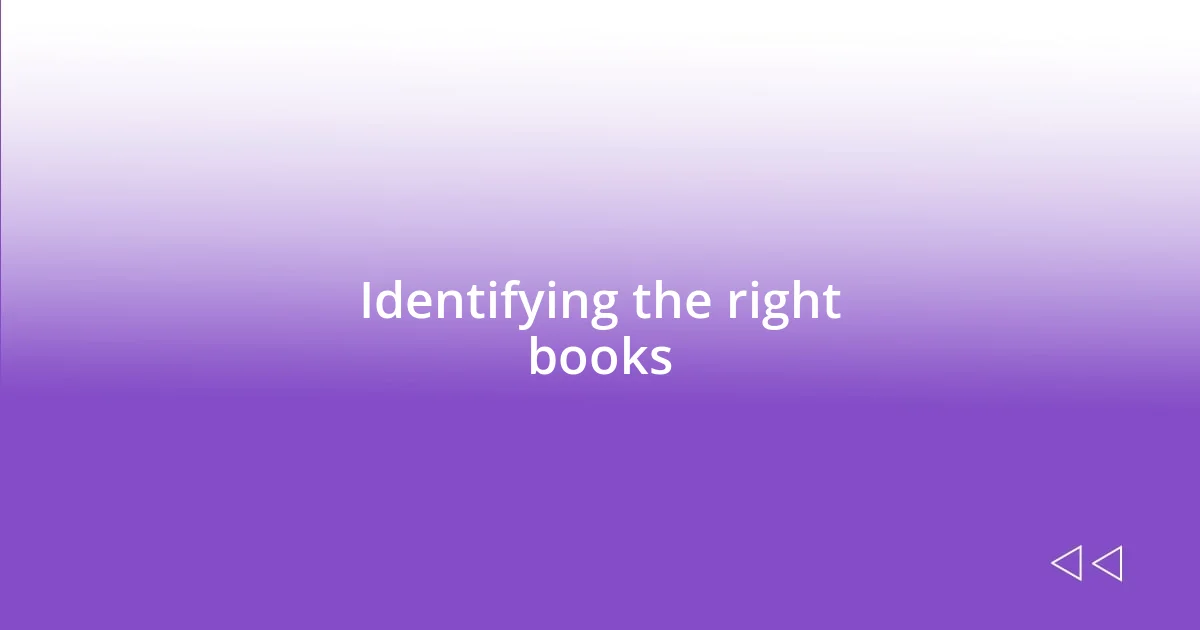
Identifying the right books
Identifying the right books can feel like a personal quest. I remember sifting through countless titles, trying to find the one that would resonate with my struggles. It’s important to look for books that speak directly to your experience; for me, those narratives often provided not just comfort but also practical tools for managing anxiety. Does a book’s genre or author make a difference? Absolutely, as connecting with the author’s voice can really enhance your understanding and healing.
As I explored, I noted the themes that seemed to offer the most support. Self-help books that shared relatable stories or offered actionable strategies worked wonders for me. I found that weaving in a bit of science made concepts easier to grasp, particularly when grounding emotions in facts. Have you ever picked up a book and felt as if the author was narrating your own thoughts and fears? It’s an exceptionally affirming experience.
I’ve also learned that intention matters when selecting a book. Are you looking for inspiration or practical exercises? Personally, I gravitated towards texts that combined both elements because they gave me the motivation to take actionable steps in my recovery. Here’s a quick summary to help distill key factors to consider when identifying the right books:
| Criterion | Example |
|---|---|
| Genre | Self-Help vs. Fiction |
| Themes | Mindfulness, Self-Compassion |
| Author’s Background | Personal Experiences vs. Professional Expertise |
| Style | Narrative vs. Academic |
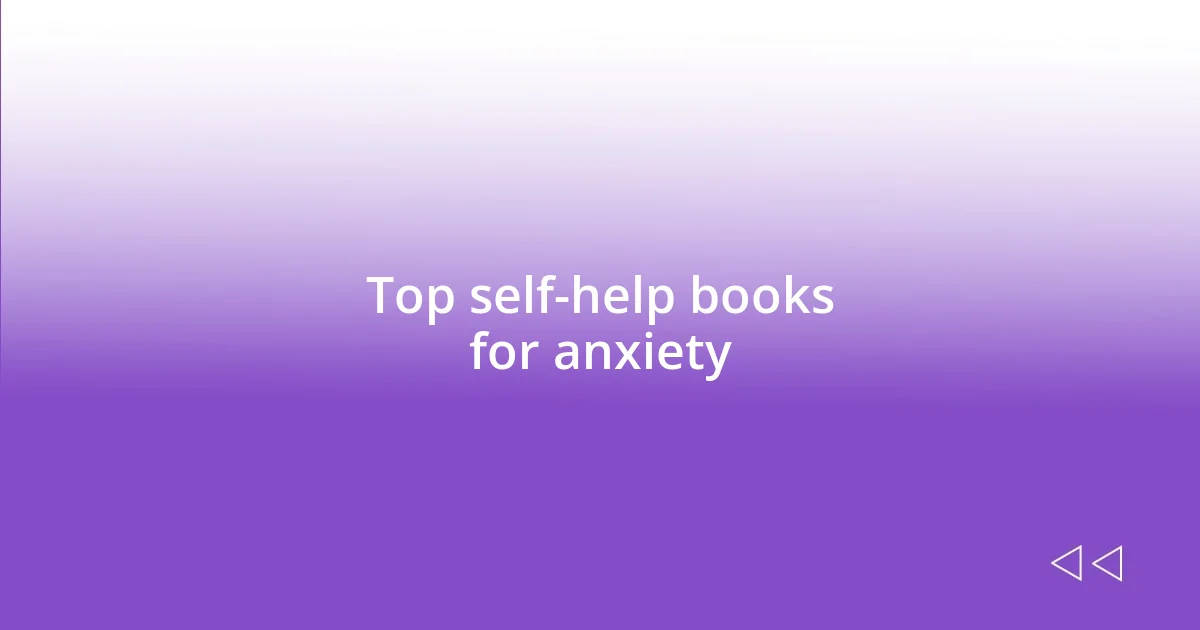
Top self-help books for anxiety
Self-help books can be a powerful ally in the journey to overcome anxiety. I remember curling up with a book that promised to give me fresh perspectives on my anxious thoughts. It was like having a wise friend beside me, guiding me through my insecurities and helping me untangle the jumble of worries I often felt. The pages were filled with strategies I could easily adopt, which made a real difference in how I approached my day-to-day life. There’s something incredibly soothing about finding someone else who has walked a similar path.
Here are some self-help books that have particularly resonated with many who struggle with anxiety:
- “The Anxiety and Phobia Workbook” by Edmund J. Bourne – A comprehensive guide filled with exercises and tools for managing anxiety.
- “The Gifts of Imperfection” by Brené Brown – Focusing on self-acceptance, this book helps develop resilience against anxiety by embracing vulnerability.
- “Feel the Fear and Do It Anyway” by Susan Jeffers – A classic that encourages taking action despite fear, offering practical steps for facing anxieties head-on.
- “Daring Greatly” by Brené Brown – Another gem by Brown that emphasizes courage and connection as pathways to overcoming anxiety.
- “Mind Over Mood” by Dennis Greenberger and Christine A. Padesky – Blending cognitive therapy techniques with practical exercises, this book empowers readers to alter their thinking patterns.
These titles sparked a flicker of hope in me, reminding me that I wasn’t alone and that change was truly possible. Each book, in its own way, felt like a revelation, showing me that the mind can be trained, and our reactions to anxiety can shift.
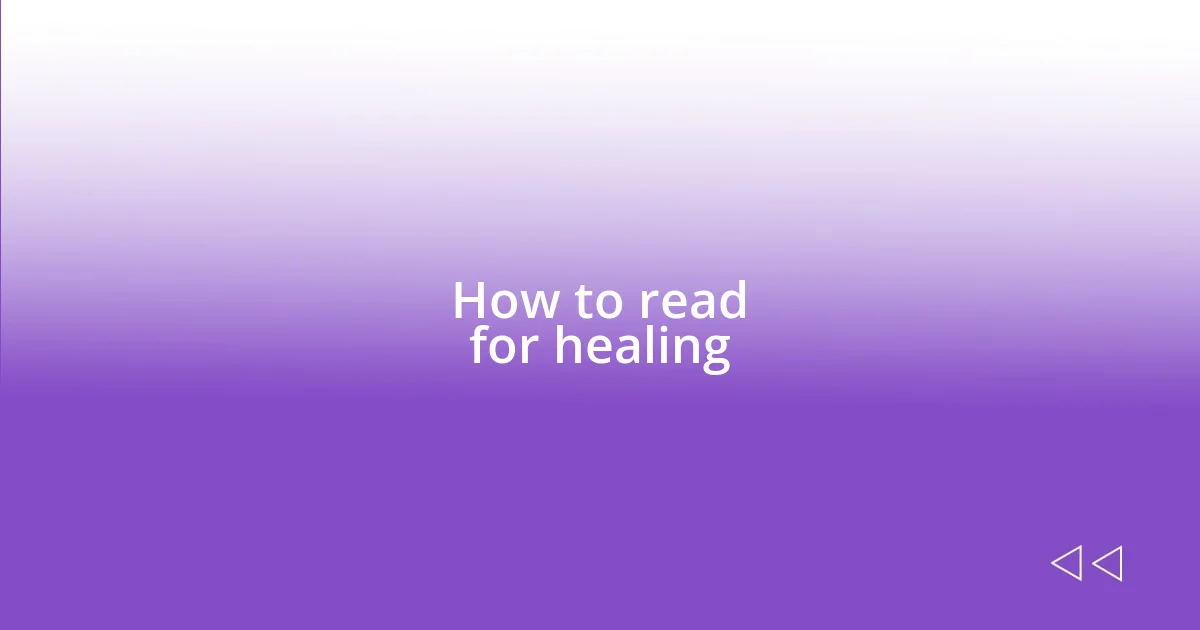
How to read for healing
Reading for healing is an experience that goes beyond mere words on a page; it’s a journey into understanding oneself. I vividly recall the way a particular book drew me in, offering not only solace but also practical exercises that I could try right away. That immediate feedback loop – reading a suggestion and then applying it the same day – made my healing process feel proactive and engaging. Have you ever felt that instant relief when a solution jumps off the page and into your life?
To truly harness the power of books for healing, I discovered the significance of creating a reading routine. I remember carving out quiet time in my day, sipping tea, and immersing myself in the stories. The environment you choose can greatly enhance your experience. Does curling up in a cozy nook elevate your reading? It certainly did for me, allowing the words to wash over me like a warm blanket, making the lessons feel intimate and personal.
Additionally, I found it helpful to pause and reflect on what I was reading. After finishing a chapter, I would jot down my thoughts or emotions in a journal. This practice helped me digest the material deeply and analyze how it resonated with my own experiences. Have you tried this? Writing about your feelings can facilitate real introspection and promote a deeper understanding of yourself as you navigate your healing journey through literature.
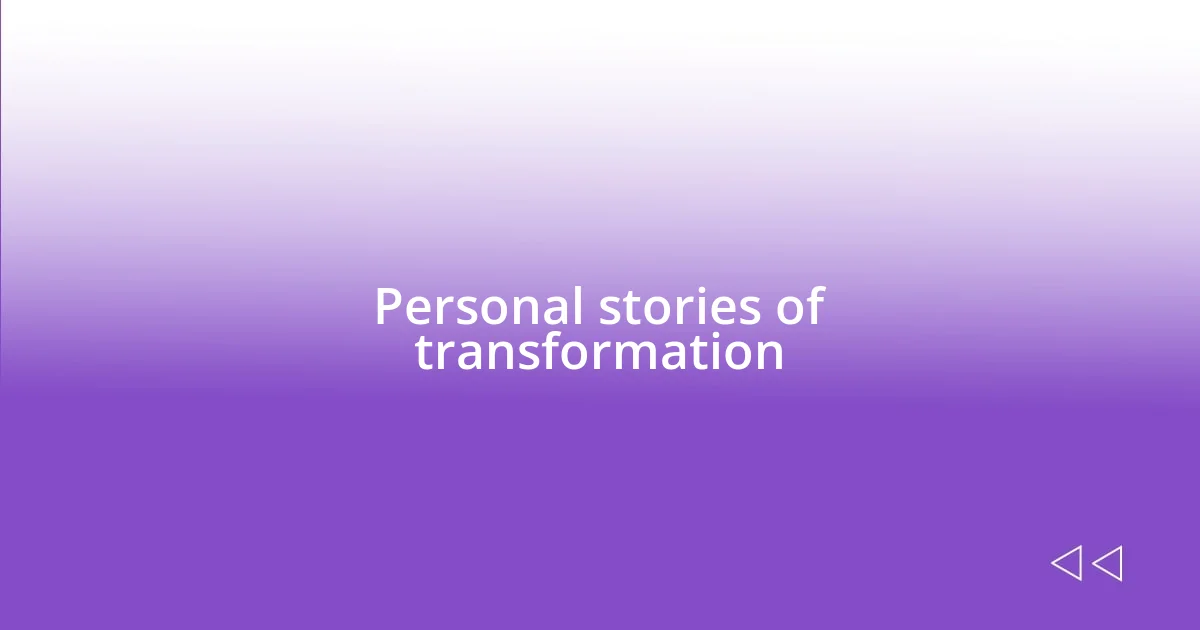
Personal stories of transformation
I remember a time when a book literally changed the way I viewed my anxiety. While flipping through “Feel the Fear and Do It Anyway,” I stumbled upon a chapter that encouraged readers to identify their fears and confront them one by one. It was a revelation. I took a deep breath and decided to tackle my fear of public speaking. Just a week later, I found myself giving a small presentation at work, my heart racing but my mind calm. That experience taught me that stepping into fear could be a gateway to transformation.
Then there was the moment I absorbed the teachings of Brené Brown in “The Gifts of Imperfection.” I found solace in her discussion about embracing vulnerability as a strength. Her words struck a chord deep within me, making me reflect on the masks I wore and the false sense of security they provided. This recognition led me to embrace my imperfections openly. I can still feel the sense of liberation that came with finally letting others see the real me. Isn’t it profound how showing our true selves can be a transformative act of courage?
Reflecting on my journey, I often think about the small victories I celebrated along the way. One day, after reading a particularly empowering passage about mindfulness in “Mind Over Mood,” I decided to try grounding techniques. Later that week, during a stressful episode at a family gathering, I remembered to pause, breathe, and reconnect with the present moment. The relief I felt was overwhelming. It’s incredible how a single sentence can spark such powerful change, reminding us that healing truly is a process, one step—and sometimes one page—at a time.
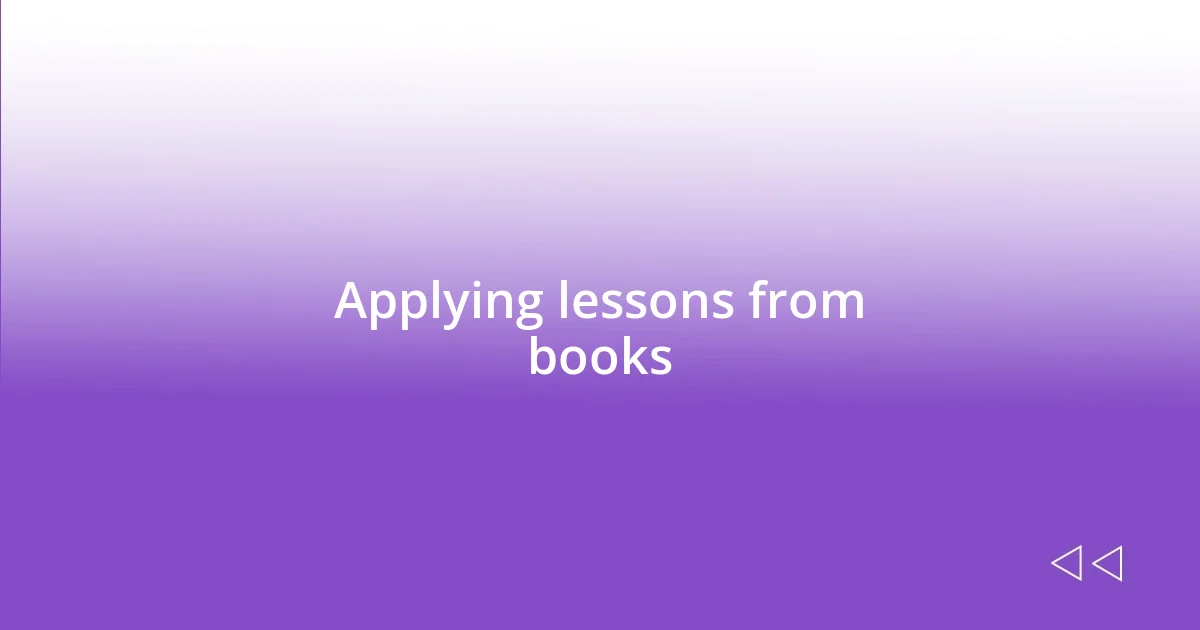
Applying lessons from books
Applying the lessons from books requires more than just reading; it’s about actively integrating those insights into daily life. I recall setting a personal challenge after reading about the power of positive affirmations in a self-help book. I started each morning by standing before the mirror, repeating affirmations like “I am enough” and “I can handle whatever comes my way.” It seemed simple, yet those few moments shifted my mindset, providing a glimmer of confidence that carried me through my day. Have you ever noticed how the right words can turn your morning around?
One strategy I found particularly helpful was creating actionable steps based on what I read. After diving into “The 7 Habits of Highly Effective People,” I began applying the habit of prioritizing urgent versus important tasks. I remember feeling overwhelmed by my to-do list, yet after prioritizing, I managed to tackle my week with a sense of clarity. Suddenly, I was not just checking off boxes; I was engaging with my responsibilities in a way that felt manageable and empowering. Isn’t it amazing how simple frameworks can profoundly impact our productivity and well-being?
Furthermore, I discovered that sharing insights from books with friends deepened my understanding. I started a casual book club, where we discussed our takeaways and the lessons we aimed to apply. I remember one evening, as we dissected a particularly poignant chapter, my friend shared how she used visualization to manage her anxiety before meetings. Her story inspired me to do the same. Has sharing your reading experience ever opened up new strategies for you? This exchange not only solidified my learning but also fostered a community of support, reminding me that healing is often a shared journey.
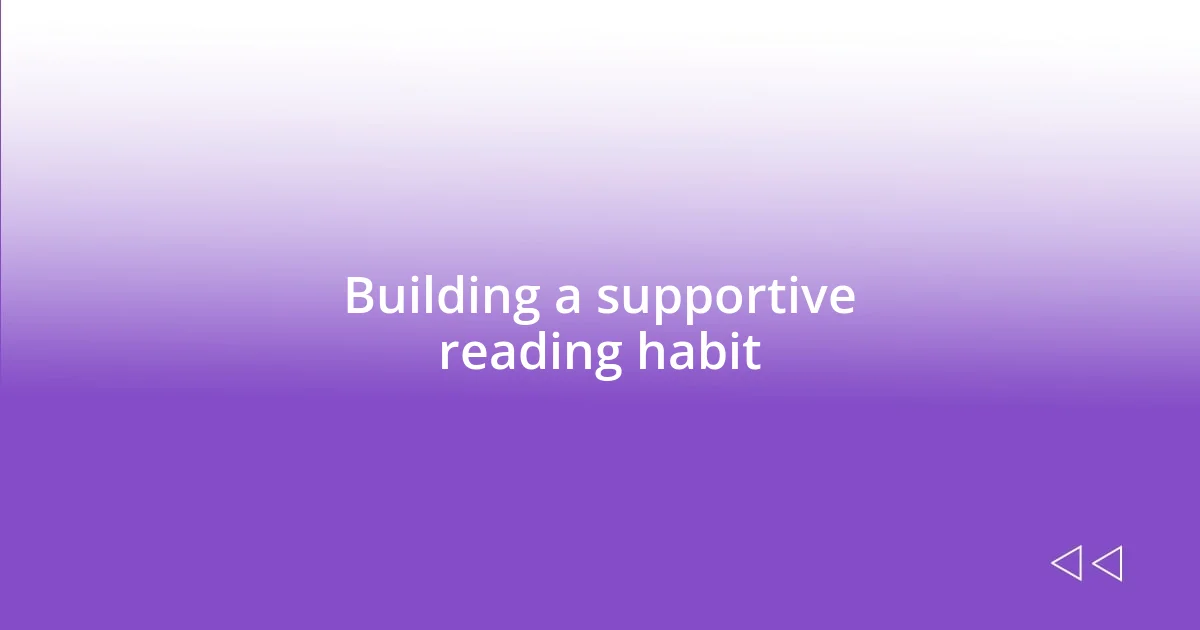
Building a supportive reading habit
Building a supportive reading habit has been a game-changer in my life. I found that setting aside specific times to read not only created anticipation but also gave structure to my day. Picture this: every evening, I’d dim the lights, brew a cup of chamomile tea, and settle into my favorite cozy nook with a book in hand. That little ritual transformed reading from a fleeting activity into a steadfast part of my routine. Have you ever noticed how a simple change in environment can enhance your reading experience?
I also discovered that surrounding myself with supportive companions made all the difference. When I started attending reading groups, I was amazed by the depth of conversations that emerged. One night, as we delved into “The Power of Now,” I shared my struggles with staying present and was met with a wave of encouragement. Listening to others’ reflections not only helped me grasp the material better but also made me feel less alone in my journey. Isn’t it powerful how community can elevate our understanding and foster a sense of belonging?
Moreover, I learned to keep a journal alongside my reading. Jotting down thoughts, questions, and emotions while I read created a dialogue with the text. I remember skimming a passage about self-compassion and feeling an urge to pause, reflect, and record my own struggles with self-criticism. Writing it down allowed me to process my feelings and track my growth over time. Ever tried connecting with your reading material in such a personal way? It’s like having a conversation with yourself, and it provides a safe space to explore your thoughts and feelings, making the reading habit not just supportive but profoundly transformative.
